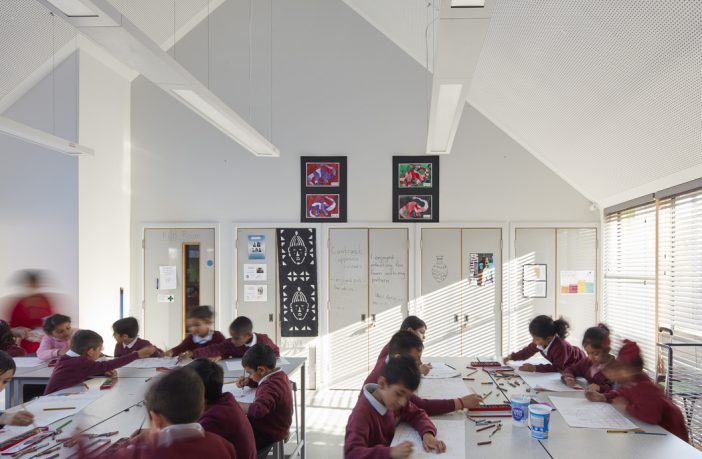Few things irritate us more than exposure to excessive noise or inability to hear what we need to hear. Whether it’s a nearby construction site, highway traffic, air conditioning, or a neighbor learning saxophone, research shows that noise can contribute to cardiovascular disease, high blood pressure, headaches, hormonal changes, sleep disturbance, reduced physical and mental performance, and the reduction of well-being. On the other hand, in an acoustically “comfortable” environment, in addition to listening to what we want, we focus better and feel calmer.
The concern about creating acoustically comfortable environments is often relegated to cinemas, concert halls and recording studios. But it is particularly important in learning environments, such as classrooms, as it directly influences the teaching-learning relationship. Acoustic discomfort can harm the process of knowledge acquisition, interfering with attention and worsening student-teacher communication.
Studies shows that uncomfortable classrooms cause discomfort and mood swings, contributing to increased stress and tiredness in students as well as decreased cognitive skills. Due to acoustic interference from outside environments in the classroom, the need to speak louder causes vocal and auditory exhaustion for teachers and students.
To better understand the issues surrounding acoustics, it is important to know some essential concepts. Sound waves, when intercepted by a receiver such as the human ear, are collected and transmitted as information to the brain: that is, they are ‘heard’. While acoustic intensity is given in decibels (dB), the tone of the sound is expressed as “frequency” through the Hertz unit (Hz). The healthy human ear is sensitive to a very wide range of frequencies, from about 20Hz to 20,000Hz. Below and above this range are infrasound and ultrasound, respectively.
It is understood that in a building, or in our case, in classrooms specifically, four types of sounds are present:
-
Outside noises (from vehicles, from the yard, from sports courts),
-
Internal noises (the teacher’s speech, parallel conversations),
-
Impact noise (footsteps, leaps),
-
Equipment noise (from air conditioning systems, fans, computers)
All these noises, together, influence the acoustic comfort of the occupants. According to the World Health Organization, the safe level of noise in a classroom cannot exceed 35 decibels. From there, the ability to learn is impaired. In France, a study found that with every 10-decibel increase in classroom noise, students’ language and math scores decreased by 5.5 points [1].
Other parameters used to describe sound distribution are:
-
Reverberation time: The time it takes for the sound level to decrease after the sound source is turned off;
-
Acoustic isolation: material characteristics of the surface areas of a space that determine the transmission of sound.
Keeping this in mind, another very important concept for a classroom is the Speech Transmission Index (STI), which refers to the quality of speech transfer to listeners. If the reverberation time (time required for the sound to “fade away” in an enclosed area after the source of the sound has stopped) in a classroom is greater than 0.6 seconds, children sitting beyond the front rows will have a hard time distinguishing between consonants and therefore will not be able to learn properly. The longer the reverberation time, the lower the comprehension ability due to sound overlap, in other words, the lower the intelligibility of the message. This means that speaking louder will not make much of a difference to clarity, and it will still make the environment more confusing (with more loudness).
But how can you improve acoustic comfort in classrooms? By applying the right products and materials, you can find effective alternatives to improve acoustics in your spaces. In order to reduce external noise input, it is ideal to acoustically insulate the building elements, which means increasing the mass of walls and slabs and investing in more watertight frames. Mass in a construction is traditionally perceived as the best provider of acoustic insulation. However, today’s lightweight construction systems, based on mass-spring-mass principles, can ensure effective external noise protection, although special care must be taken in considering the specification and detailing of such construction systems.
Absorbent materials, such as mineral wool in ceiling or wall panels, or mortar or acoustic plasterboard, will help to reduce overhead and impact noise within the building, which will also be influenced by the choice of wall or floor covering. Objects that scatter sound on walls, or wall absorbers, eliminate disturbing echoes that may occur between the walls, so-called “vibrating echoes”. More porous materials on interior surfaces (especially ceilings) will also help to reduce reverberations, improving speech intelligibility.
Improving classroom acoustics is therefore critical to a proper teaching-learning process. The gains affect students as well as educators, who won’t need to exceed their voices’ limits. Architects play a big role in this throughout the project.
Author: Eduardo Souza
Notes
[1] Pujol S, Levain JP, Houot H, Petit R, Berthillier M, Defrance J, Lardies J, Masselot C, Mauny F. Association between ambient noise exposure and school performance of children living in an urban area: a cross-sectional population-based study. Journal of Urban Health, 91(2), 256-271.
This article was first published in Arch Daily and is republished with permission.

















